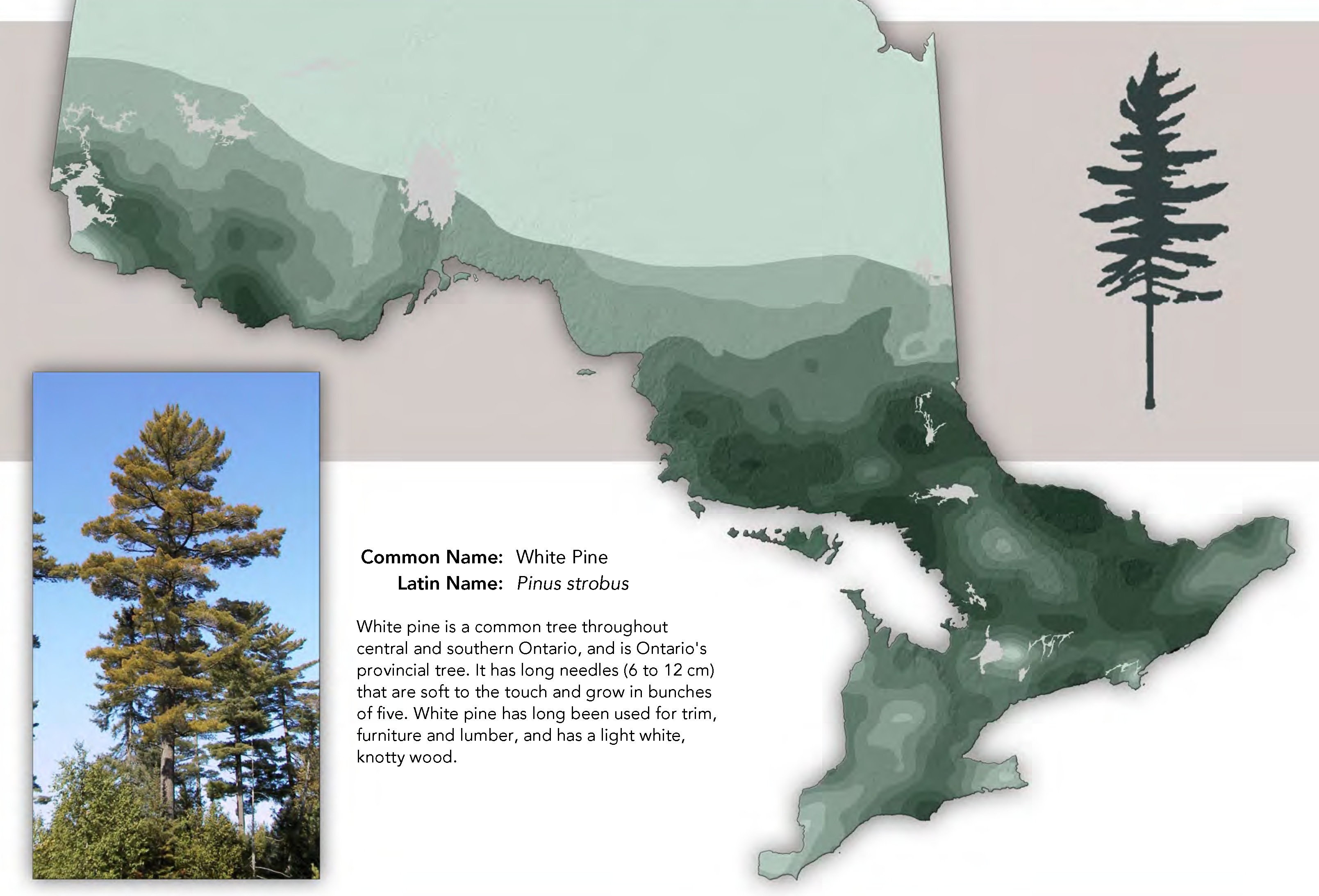Genetic diversity is the combination of different genes found within a population and the pattern of variation found within different populations of the same species (Frankham et al. 2002). It is shaped by past population processes and affects the viability of species and populations in the future. Genetically diverse organisms are thought to be better able to withstand and adapt to environmental changes, to pass on those traits to descendants and to contribute positively to the persistence of species, populations and ecosystems (Strubig et al. 2011).
Once a predominant tree species in the forested landscapes of Ontario, Eastern White Pine (Pinus strobus) has undergone fundamental changes in population structure and dynamics over last 150 years (Buchart 1994). Forest fire suppression, extensive stand harvesting and high grading (i.e., selective harvesting of only the best trees from the stand) has resulted in fragmentation and the creation of small, isolated populations that are subject to inbreeding. More recently, White Pine Blister Rust, an alien invasive tree pathogen, has hindered regeneration efforts, particularly in northern Ontario (Pitt et al. 2006). As well, climate change has increased pressures on Eastern White Pine populations, altering the habitat and making some populations vulnerable to losing optimal conditions for growth (Joyce and Rehfeldt 2013).
Figure 1. Abundance of eastern white pine in Ontario (source: Watkins 2011).
Intact, pristine old-growth Eastern White Pine stands in Ontario provide a unique opportunity to develop benchmarks for the levels of genetic diversity inherent in these virgin stands and for examining the genetic effects of observed changes in the population structure. A study by Rajora et al. (2000) compared genetic diversity between pre-harvest pristine and post-harvest residual gene pools of two adjacent, old-growth stands of Eastern White Pine in Ontario. The results demonstrate a reduction in genetic diversity in the post-harvest residual gene pools of the two old-growth stands. Also, all of the genetic losses were low-frequency or rare alleles, which may compromise the integrity of locally adapted gene pools and the ability of Eastern White Pine to respond to changing environmental conditions.
Despite these challenges, progress has been made to address the genetic issues related to Eastern White Pine in Ontario. The cornerstone of managing genetic diversity and ensuring an effective artificial regeneration program has been the control of tree seed and stock transfer to ensure the use of well adapted plant material. In 2000, the Forest Gene Conservation Association renewed the management of white pine seed orchards that were established in southern Ontario 30 years ago in recognition of their gene conservation value. Eastern White Pine seed from these orchards can be banked for many years to support annual afforestation programs and also mitigate the potentially negative climate change effects on seed crop frequency. As a source of southern material, this seed can also support assisted migration efforts for climate change adaptation.
In areas where White Pine Blister Rust frequently causes Eastern White Pine regeneration failure, the deployment of blister rust resistant Eastern White Pine hybrid backcrosses with Himalayan White Pine can potentially help restore ecosystem functions of Eastern White Pine on high hazard sites. Ontario has bred Eastern White Pine hybrid backcrosses carrying up to 94% Eastern White Pine pedigree, which have demonstrated almost identical characteristics of Eastern White Pine and strong genetic resistance to White Pine Blister rust, as well as promising growth performance in field research trials (Lu and Sinclair 2006; Lu and Derbowka 2009). Using a technique called somatic embryogenesis to vegetatively propagate hybrid white pine genotypes with strong genetic resistance to Blister Rust resistance and outstanding growth can help restore Eastern White Pine ecosystem functions and support conservation.
References
Buchert, G.P. 1994. Genetics of white and implications for management and conservation. Forestry Chronicle 70:427-434.
Frankham, R., J.D. Ballou, and D.A. Briscoe. 2002. Introduction to conservation jenetics. Cambridge University Press. Cambridge, U.K.
Joyce, D.G., and G.E. Rehfeldt. 2013. Climatic niche, ecological genetics, and impact of climate change on eastern white pine (Pinus strobus l.): guidelines for land managers. Forest Ecology and Management 295:173–192.
Lu, P., and D. Derbowka. 2009. Breeding eastern white pine for blister rust resistance: a review of progress in Ontario. The Forestry Chronicle 85:745-755.
Lu, P., and R.W. Sinclair. 2006. Survival, growth, and wood specific gravity of interspecific hybrids of Pinus strobus and P. wallichiana grown in Ontario. Forest Ecology and Management 234:97-106.
Pitt, D.G., T. Meyer, M. Park, L.M. MacDonald, T.M. Buscarini, and D.G. Thompson. 2006. Application of slow-release tablets to enhance white pine regeneration: growth response and efficacy against white pine blister rust. Canadian Journal of Forest Research 36:684–698.
Rajora, O.P., M.H. Rahman, G.P. Buchert, and B.P. Dancik. 2000. Microsatellite DNA anlaysis of genetic effects of harvesting in old-growth eastern white pine (Pinus strobus) in Ontario, Canada. Molecular Ecology 9:339-348.
Struebig, M.J., T. Kingston, E.J. Petit, S.C. Le Comber, A. Zubaid, A. Mohd-Adnan, and S.J. Rossiter. 2011. Parallel declines in species and genetic diversity in tropical forest fragments. Ecology Letters 14:582-590.
Watkins, L. 2011. The forest resources of Ontario 2011. Ontario Ministry of Natural Resources, Queen’s Printer for Ontario, Sault Ste. Marie, ON.

